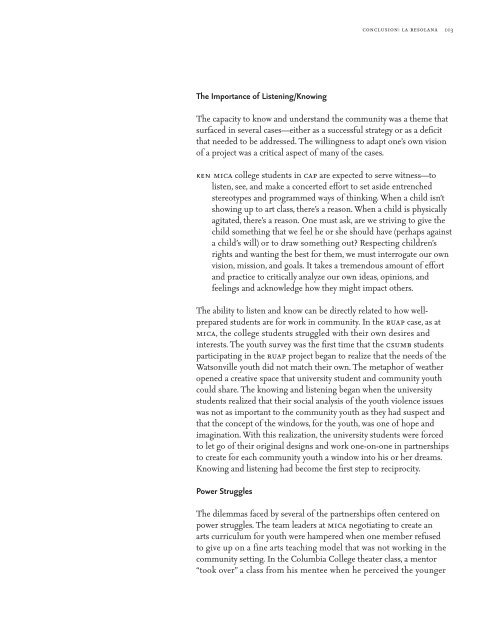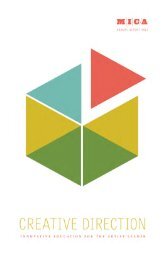art/vision/voice - Maryland Institute College of Art
art/vision/voice - Maryland Institute College of Art
art/vision/voice - Maryland Institute College of Art
You also want an ePaper? Increase the reach of your titles
YUMPU automatically turns print PDFs into web optimized ePapers that Google loves.
The Importance <strong>of</strong> Listening/Knowing<br />
The capacity to know and understand the community was a theme that<br />
surfaced in several cases—either as a successful strategy or as a deficit<br />
that needed to be addressed. The willingness to adapt one’s own <strong>vision</strong><br />
<strong>of</strong> a project was a critical aspect <strong>of</strong> many <strong>of</strong> the cases.<br />
ken mica college students in cap are expected to serve witness—to<br />
listen, see, and make a concerted effort to set aside entrenched<br />
stereotypes and programmed ways <strong>of</strong> thinking. When a child isn’t<br />
showing up to <strong>art</strong> class, there’s a reason. When a child is physically<br />
agitated, there’s a reason. One must ask, are we striving to give the<br />
child something that we feel he or she should have (perhaps against<br />
a child’s will) or to draw something out? Respecting children’s<br />
rights and wanting the best for them, we must interrogate our own<br />
<strong>vision</strong>, mission, and goals. It takes a tremendous amount <strong>of</strong> effort<br />
and practice to critically analyze our own ideas, opinions, and<br />
feelings and acknowledge how they might impact others.<br />
The ability to listen and know can be directly related to how wellprepared<br />
students are for work in community. In the ruap case, as at<br />
mica, the college students struggled with their own desires and<br />
interests. The youth survey was the first time that the csumb students<br />
p<strong>art</strong>icipating in the ruap project began to realize that the needs <strong>of</strong> the<br />
Watsonville youth did not match their own. The metaphor <strong>of</strong> weather<br />
opened a creative space that university student and community youth<br />
could share. The knowing and listening began when the university<br />
students realized that their social analysis <strong>of</strong> the youth violence issues<br />
was not as important to the community youth as they had suspect and<br />
that the concept <strong>of</strong> the windows, for the youth, was one <strong>of</strong> hope and<br />
imagination. With this realization, the university students were forced<br />
to let go <strong>of</strong> their original designs and work one-on-one in p<strong>art</strong>nerships<br />
to create for each community youth a window into his or her dreams.<br />
Knowing and listening had become the first step to reciprocity.<br />
Power Struggles<br />
conclusion: la resolana 103<br />
The dilemmas faced by several <strong>of</strong> the p<strong>art</strong>nerships <strong>of</strong>ten centered on<br />
power struggles. The team leaders at mica negotiating to create an<br />
<strong>art</strong>s curriculum for youth were hampered when one member refused<br />
to give up on a fine <strong>art</strong>s teaching model that was not working in the<br />
community setting. In the Columbia <strong>College</strong> theater class, a mentor<br />
“took over” a class from his mentee when he perceived the younger
















